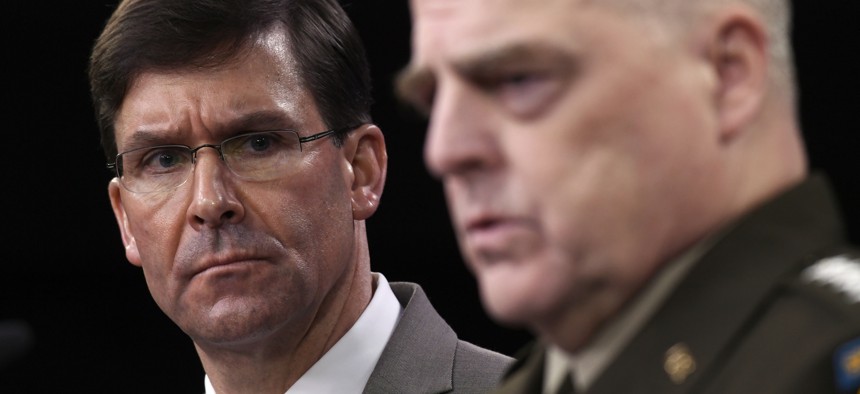
Defense Secretary Mark Esper, left, listens as Chairman of the Joint Chiefs of Staff Army Gen. Mark Milley, right, speaks during a briefing at the Pentagon in Washington, Monday, March 2, 2020. AP Photo/Susan Walsh
How the Pentagon Should Get into the Coronavirus Fight at Home
Beds, vaccines, money – after protecting troops abroad, Esper should turn DOD's focus to protecting Americans right here.
This may be the most life-threatening, and life-changing, moment for most Americans since the September 11 attacks. The Defense Department has historically played a central role in global pandemic response abroad — most recently, the U.S. response efforts to Ebola in West Africa, Now, it should help mitigate the impact of COVID-19 virus right here at home. There are three ways the department needs to lean in now, with hospital beds, vaccines, and money.
Secretary Mark Esper and senior military leaders have already taken some action to slow the spread of the virus to U.S. troops around the world by focusing first on the health of the force – including robust travel restrictions. While their health and readiness should remain a priority, the department now also needs to begin actively supporting a national response that will more directly mitigate the virus’ impact on the American public, and begin planning for the worst-case scenarios.
First, get seen. It has been surprising that Esper and Joint Chiefs Chairman Gen. Mark Milley have not been more visible in the Trump administration’s COVID-19 response efforts. They have not appeared at President Trump’s recent press conferences and do not even sit on the White House COVID-19 Task Force. They should.
The 2018 National Defense Strategy makes no mention of a DOD role in pandemic response – its focus is on defending against an armed attack, and competition with Russia and China. Unfortunately, as we are seeing, global pandemics can threaten the homeland just as any Russian bomber or Chinese submarine — and potentially more so.
In February, Esper activated the Department of Defense’s Global Campaign Plan for Pandemic Influenza and Infections Disease to protect U.S. forces abroad. Now it is time to protect Americans with a “homeland campaign” plan. The military already has the authorities, resources, and capacity to augment a national civilian-directed pandemic response.
There are three key areas where the military should help:
Mobile hospital construction and supplemental beds: U.S. Africa Command, or AFRICOM, supplied field hospital bed capacity called Monrovian Mobile Units to the U.S. Ebola response in West Africa. AFRICOM personnel who worked this issue should be sharing lessons learned with U.S. Northern Command, or NORTHCOM, which has the lead for any homeland response. Esper could even issue an EXORD (an “execute order” command) to prepare to provide these mobile units to U.S. localities, if requested. Further, there are military bases across the United States that have medical facilities. The Joint Chiefs and NORTHCOM should be working to determine whether these bases have any excess hospital beds that could be used by local authorities. DOD should also review what fast-track contracting authorities and capacity may be available to help states to race to build hospital or medical facilities. While there may be limits to what DOD can provide, a serious department assessment needs to happen now, driven by Secretary Esper.
Related: Dems Call for ‘War’ on Coronavirus, But Military Says Help is Limited
Related: As Coronavirus Explodes in Italy, Doctors Are Forced to Choose Who Gets Care
Related: The Prognosis: Latest News on Coronavirus & National Security
Vaccine testing and development: The U.S. Army Institute of Medical Research has vaccine research and development programs around the world. It was heavily involved in Ebola, Zika, and MERS early vaccine research and development. It should be activated immediately for vaccine testing on COVID-19. The U.S. Army Medical Research and Development Command also has tremendous biomedical capacity to assist in testing, vaccine development, lab surge capacity, etc. It is likely some of these efforts are already quietly underway, but they certainly need to have the attention of Department leadership and integrated into the national response.
Funding transfers: It is highly likely that U.S. civilian departments and agencies will need additional funding. While the declaration of national emergency will unlock about $50 billion in federal funding to flow to states and even though Congress is working to pass additional supplemental funding, DOD has budgetary resources that it could use in support of national pandemic response, including funding transfers to HHS, DHS, and FEMA if necessary. During the Ebola response in 2014, DOD used the Overseas Contingency Operations, or OCO, war-spending account to transfer about $408 million to support the U.S. response by 2015. While there has been congressional opposition to DOD funding transfers to support Trump’s border wall construction, there would likely be widespread bipartisan support for funding transfers in support of a homeland response to COVID-19.
The challenge of COVID-19 should force the Pentagon to think differently and creatively about what it means to defend the U.S. homeland. And while there is a reasonable balance to be struck, the Department of Defense has the capacity and resources to play a major role in our national response to this pandemic and the Pentagon’s leaders can provide important reassurance to the American public during national crisis. It is incumbent on them to raise their hand and offer to help.
Kelly Magsamen is vice president for national security and international policy at the Center for American Progress. She formerly served in senior roles in the Pentagon and National Security Council staff.
NEXT STORY: America Is Acting Like a Failed State




